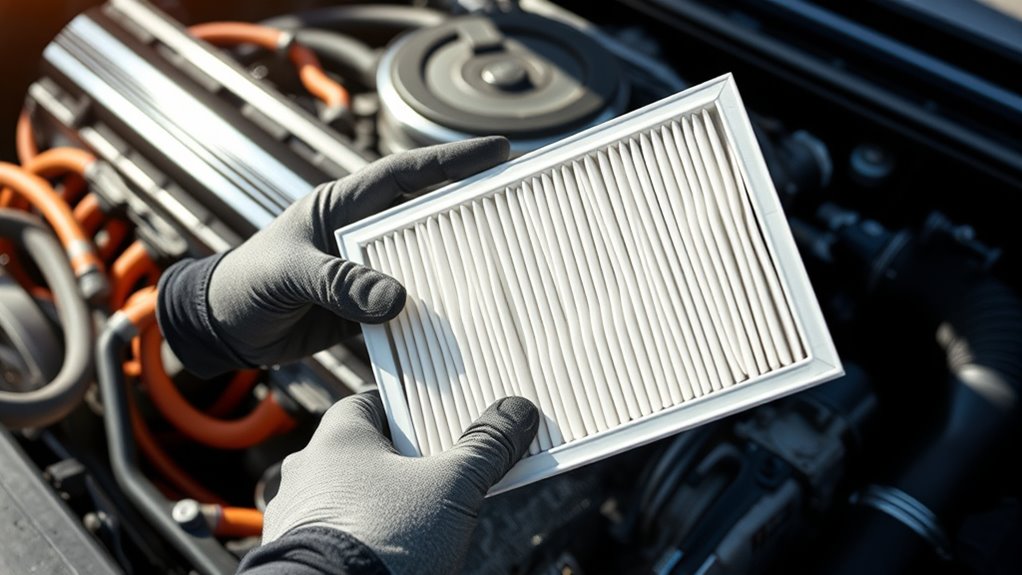Replacing your engine air filter yourself is simple and cost-effective. First, make sure you have the correct filter for your vehicle. Park on a flat surface, locate the filter housing, and remove the fasteners. Take out the old filter, clean the housing, and carefully install the new one, making sure it fits snugly. Reattach the cover securely. If you want to master this quick maintenance task, you’ll find useful tips just ahead.
Key Takeaways
- Gather the correct replacement air filter and tools, then locate the filter housing under the hood.
- Remove fasteners, lift the housing cover, and take out the old filter carefully.
- Inspect and clean the housing interior to ensure no dirt or debris remains.
- Insert the new filter correctly, ensuring a snug fit and proper orientation.
- Reattach the cover securely, double-check the seal, and dispose of the old filter properly.

Replacing your engine air filter yourself is a simple and cost-effective way to keep your vehicle running smoothly. Regular air filter maintenance is essential to ensure your engine breathes clean air, which directly impacts engine performance. When your air filter gets dirty or clogged, it restricts airflow, causing your engine to work harder. This can lead to decreased fuel efficiency, sluggish acceleration, and increased emissions. By taking a few minutes to replace the air filter yourself, you not only improve your vehicle’s performance but also save money on costly repairs down the line.
Replacing your air filter is an easy way to boost performance and save money on repairs.
Before you begin, make sure you have the correct replacement filter for your vehicle. Consult your owner’s manual or ask at your local auto parts store to find the right fit. Once you have the new filter, park your vehicle on a flat surface, turn off the engine, and engage the parking brake. Open the hood and locate the air filter housing—usually a black plastic box near the top of the engine bay. In some vehicles, it may be secured with clips, screws, or clamps. Use a screwdriver or your hands to remove these fasteners carefully. Keep track of how the housing comes apart so you can reassemble it easily later.
Carefully lift the cover off the air filter housing. Remove the old filter and dispose of it responsibly. Take a moment to inspect the inside of the housing for dirt, debris, or leaves, and clean it out with a damp cloth or a soft brush. Now, insert the new air filter into the housing, making sure it sits snugly and correctly oriented. An improperly installed filter can allow unfiltered air to bypass it or cause it to shift during driving. Once the new filter is in place, replace the cover and fasten it securely with clips, screws, or clamps. Double-check that everything is sealed properly to prevent unfiltered air from entering the engine.
Regularly inspecting your air filter can help prevent clogged filters from reducing engine efficiency and causing unnecessary wear. Replacing your engine air filter is quick, usually taking less than 10 minutes. It’s a small task that makes a significant difference in maintaining your vehicle’s overall health. You’ll notice smoother engine operation, improved acceleration, and better fuel economy—proof that good air filter maintenance pays off. Plus, doing it yourself gives you a sense of accomplishment and a better understanding of your vehicle’s mechanics. Remember to check your air filter regularly, especially if you drive in dusty or polluted environments. A clean, well-maintained air filter is key to keeping your engine performing at its best.
Frequently Asked Questions
How Often Should I Replace My Engine Air Filter?
You should replace your engine air filter every 12,000 to 15,000 miles, but this depends on your driving conditions. Air filter lifespan varies; if you drive in dusty or polluted environments, consider checking it more often. Regular replacement intervals ensure your engine runs efficiently and prevents damage. Always inspect your air filter during routine maintenance, and replace it sooner if it looks dirty or clogged to keep your vehicle performing at its best.
Can I Clean and Reuse My Engine Air Filter?
You can sometimes clean and reuse your air filter, depending on its materials. If your filter is made of foam or cotton, you might clean it with compressed air or a gentle wash, then let it dry completely before reinstalling. However, paper filters shouldn’t be reused or cleaned, as they’re designed for single use. Always check your filter’s materials and manufacturer’s guidelines to decide if reusing filters is safe and effective.
What Tools Are Needed for Air Filter Replacement?
While tools are simple, replacing your engine air filter feels like a high-stakes task. You’ll need basic tools like screwdrivers or socket wrenches, depending on your car’s air filter types. Start by opening the air filter cover, removing the old filter, and installing the new one. Follow the replacement steps carefully, ensuring the filter sits properly. With a few tools and patience, you’ll keep your engine breathing easy.
Are There Signs Indicating My Air Filter Needs Replacement?
You’ll notice your air filter needs replacing if your engine performance declines, like reduced acceleration or rough idling. Poor air quality may also cause increased engine noise or a check engine light. If you see dirt, debris, or a visibly clogged filter, it’s time for a change. Regularly inspecting your filter ensures your engine runs smoothly and maintains ideal air quality, preventing potential damage and improving fuel efficiency.
Is It Safe to Drive With a Clogged Air Filter?
Driving with a clogged air filter isn’t safe because it can harm your engine performance and reduce air quality inside your vehicle. A dirty filter restricts airflow, leading to poor acceleration, increased fuel consumption, and engine strain. You might also notice rough idling or stalling. To keep your car running smoothly and guarantee good air quality, replace the air filter promptly when you detect signs of clogging.
Conclusion
Replacing your engine air filter yourself not only saves money but also improves your vehicle’s performance. Did you know that a clean filter can boost fuel efficiency by up to 10%? By following these simple steps, you guarantee your engine breathes easier and runs smoother. Regular maintenance like this can extend your engine’s lifespan and save you costly repairs down the line. Keep your car in top shape—it’s a small effort with big rewards.









